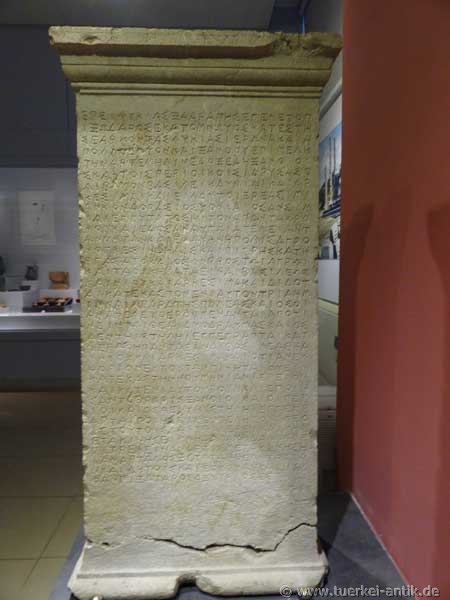 |
| Letoon | |||
|
|
|
||
| The Temple of Leto | |||
|
The Letoon was the ancient sanctuary of the nearby city of Xanthos and the Lycian Covenant. Leto, Artemis and Apollon were venerated here for over eight centuries until the Roman Empire. The ruins of the temples and magnificent buildings, together with the remains of Xanthos, have been a UNESCO World Heritage Site since 1988. The two sites in Lycia are about 65 km southeast of Fethiye. |
|||
|
|
|||
| From left to right: Temple of Leto, Temple of Artemis, Temple of Apollo | |||
|
On a small rocky ridge between two swamps the foundations of three temples are arranged parallel. The middle building from the 4th century B.C. is the smallest and oldest and was dedicated to Artemis. In his former cella he includes a sacred rock that was apparently already worshipped in archaic times. To the east, in the 2nd century B.C., the temple of Apollo was built over a 200 year older predecessor building. In the west, a peripteral temple dedicated to Leto was built around 160 B.C. as the largest complex. All three buildings are badly damaged. |
|||
|
|
|||
| The Temple of Apollon | |||
|
|
|||
| The Temple of Leto | |||
|
Ceramic finds from the 8th century B.C. prove the early history of this place. Here, at a spring, the place of Greek mythology was venerated, where Leto washed her children Artemis and Apollo in Lycia in holy water while fleeing Hera. The history of the Shrine is closely linked to that of Xanthos, who for a long time led the Lycan Covenant. |
|||
|
|
|||
| At the Agora | |||
|
|
|||
| Here too the problem of the excavators: groundwater | |||
|
|
|||
|
The holy spring lay in the swamp area immediately to the south. Foundations have shown that there was already a place of worship here in archaic times. Today, the remains of a magnificent nymphaion from the Roman imperial period can be seen here. The semicircular cobbled pool with a diameter of 27 metres adjoins a rectangular, recessed well house. Exactly here, in the centre of the place of worship, the monastery was built in early Christian times, which covers parts of the Roman building. |
|||
|
|
|||
|
|
|||
|
Turtles benefit from high groundwater level |
|||
|
|
|||
|
All common ritual celebrations, theatre performances and competitions of the Lycian cities took place here, in Letoon. A several times extended Stoa and a small theatre testify to this. Even in the time of Hadrian, the sacred spring was placed in a new, magnificent nymphaion (fountain building). The stadium has not yet been found. A monastery was built in the early Christian period, but with the onslaught of the Arabs in the 7th century the settlement of the village ends. Excavations have been taking place since 1962. |
|||
|
|
|||
|
|
|||
|
The right entrance (parodoi) to the theatre |
|||
|
A third building complex is located in the swamp meadow north of the temple. The Stoa was also laid out in archaic times and extended several times until the 2nd century AD. The Hellenistic theatre, only a short distance away, whose stage house is no longer preserved, is larger than a semicircle and divides the rows of seats into an upper and lower tier with a diazoma. |
|||
|
|
|||
| The Theatre | |||
|
|
|||
|
Trilingual stela from Letoon with almost identical inscriptions in Greek, Aramaic and Lycian. |
|||
|
In 1973, an inscribed stele was found near the temple of Apollo, which fascinated linguists and historians alike and is now in the Fethiye Museum. In terms of content, it is a decree that ordered the introduction of a Carian cult of the gods in Xanthos. The special: The decree was written almost word for word in three languages, Aramaic (the Persian court language), Lycian and Greek. It is historically significant that it was issued by Pixodares in his capacity as Satrap of Caria and Lycia in 358 BC. |
|||
| Photos: @chim | |||
| Translation aid: www.DeepL.com/Translator | |||
| Source: Wikipedia and others | |||
|
|
|||


